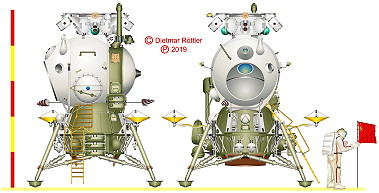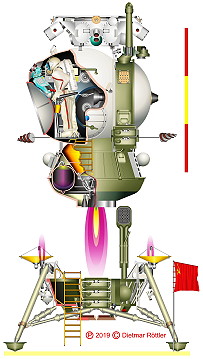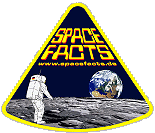Cancelled Spaceflights
![]()
L3-1USSR |
![]()
Planning data
Crew
|
Backup Crew
|
Mission objectives
|
Planned as the first Soviet lunar landing
mission. The first L3 mission probably was planned for somewhere in 1969 or
1970, if the first launches of the N1 rocket had been successful in 1969. They
were not, and the program began slipping. planned flight profile for a lunar landing: - Launch of the N1 rocket with 2 crew members aboard the LOK spaceship - Discharge of the payload fairing and the rescue system - Swinging into a nearly circular Earth orbit at a height of 220 km at 51.6° orbit inclination - 24 hour flight phase in Earth orbit to test the systems - Ignition of the block G engine of the N1 for 8 minutes and thus injection into a highly elliptical Earth orbit with free return path to the Earth - Flight time to the Moon about 101 hours with two course correction options - During the flight on the moon back, block D of the N1 brakes the combination into a lunar orbit for several minutes by ignition - Further ignitions of the block D to lower the lunar orbit at 100 x 20 km altitude - As there would be no lock between LK-Lander and LOK spaceship, the lunar cosmonaut would have to switch in an outboard maneuver - The housing module of the Soyuz would have served as an airlock, and the cosmonaut would have been hoisted to the lander with the help of a mechanical crane - Descent of the LK lander to about 2000 meters above the lunar surface using the block D of the N1 rocket - Separation of the block D and deliberate crash on the lunar surface - Remaining descent of the LK-Landers with the engine RK-858 or the reserve engine RK-859 - During the descent, the speed of 100 meters per second would have to be reduced within 50 to 60 seconds - The cosmonaut on board would then have had another minute to hover to find a suitable landing site - Planned length of stay on the lunar surface about 90 minutes - Return from the Moon with the LK-Lander, for which fuel would have been available for about 350 seconds burn time - Coupling of the LK-Lander to the LOK spaceship (active spacecraft) - The lunar cosmonaut would have moved in an outboard maneuver together with the soil samples back to the LOK spaceship - Separation first of the LK lander and then the orbital module still in the lunar orbit - In the 39th moon orbit engine ignition to bring the LOK spaceship (only landing module and instrument part) back to Earth - Two hours before entering the Earth's atmosphere, the drive and device module would have been separated - landing on a parachute in the Indian Ocean |
Graphics
 |
 |
 |
 |
 |
 |
| © |  |
Last update on July 02, 2019.  |
 |